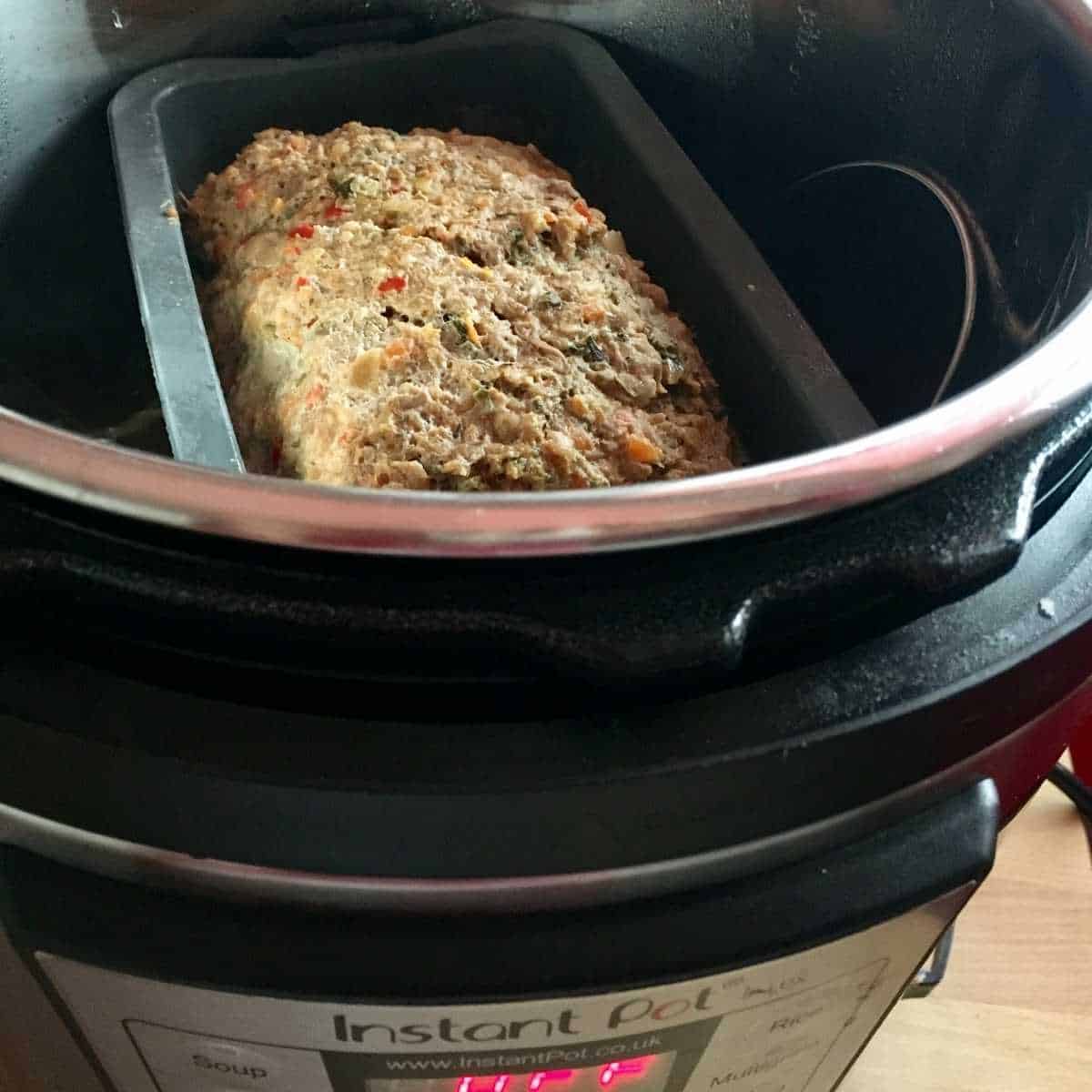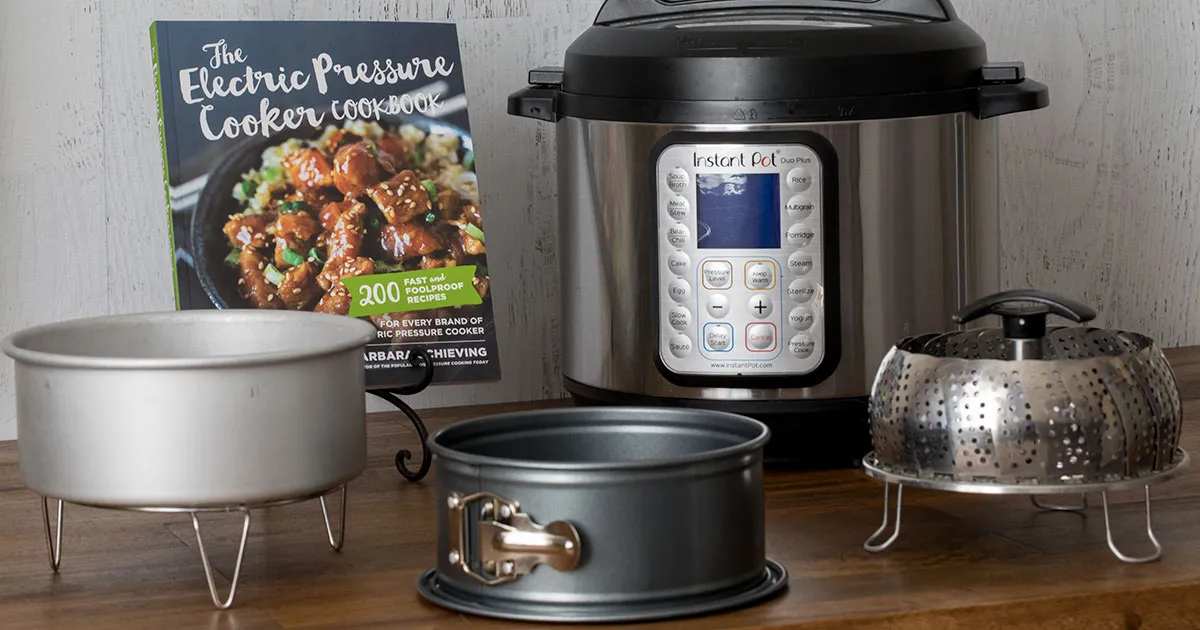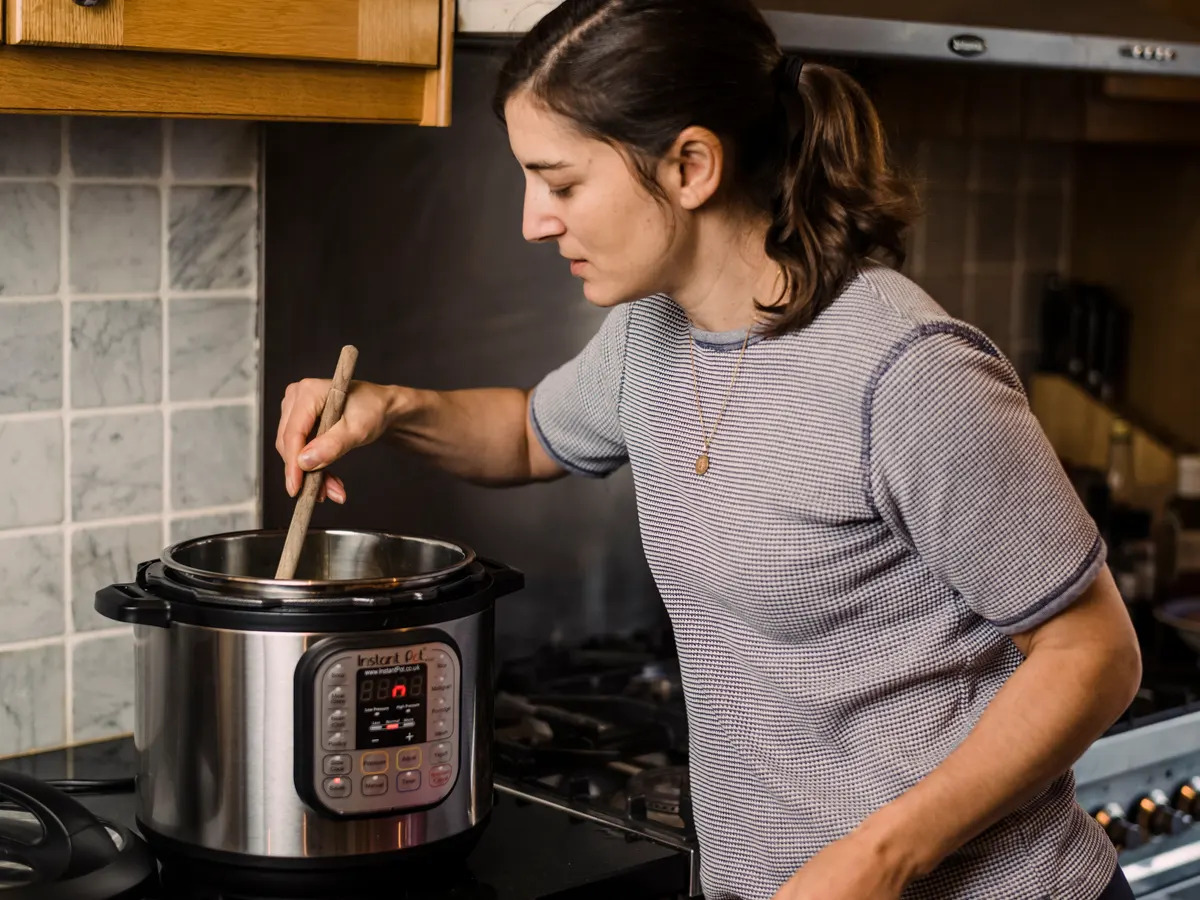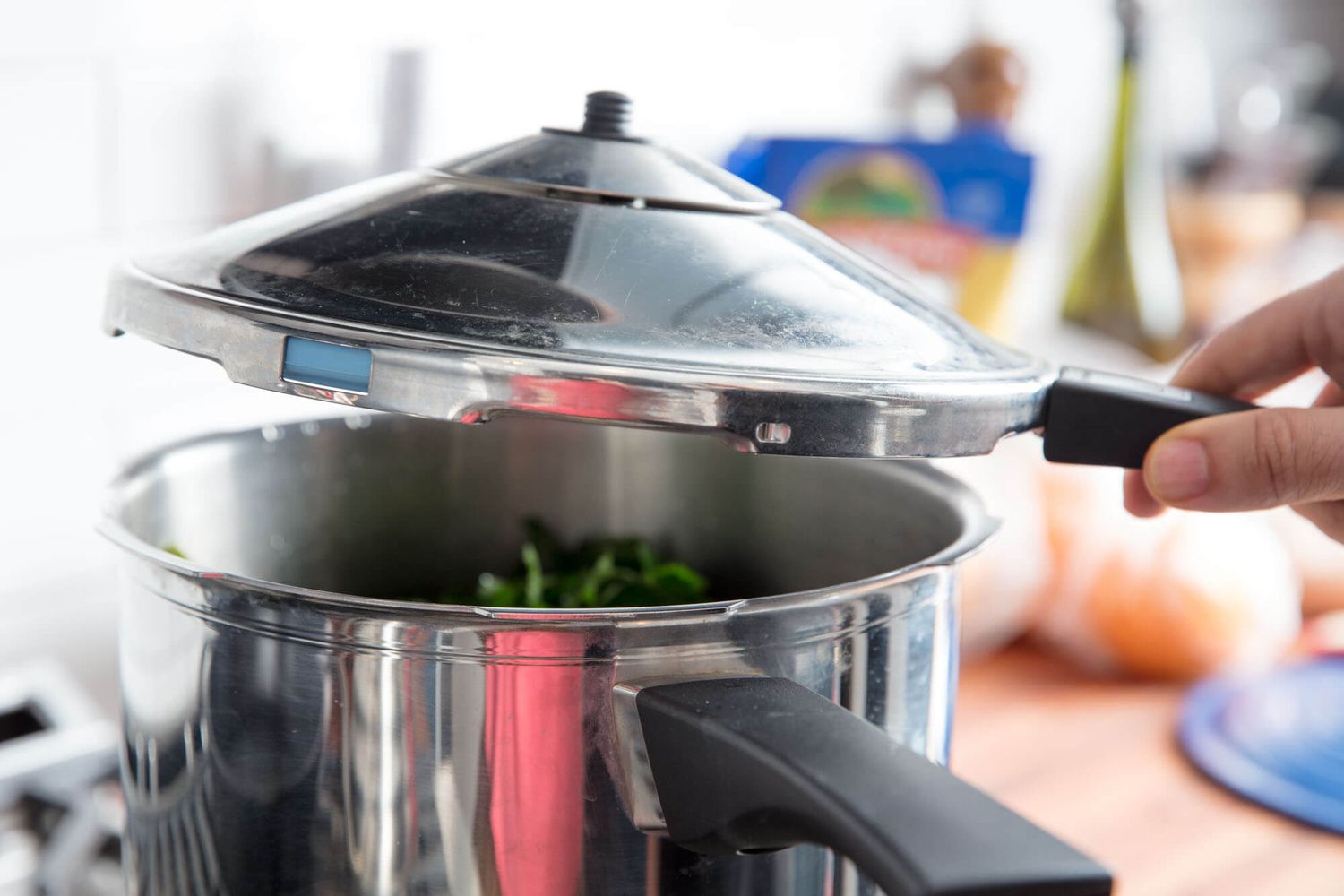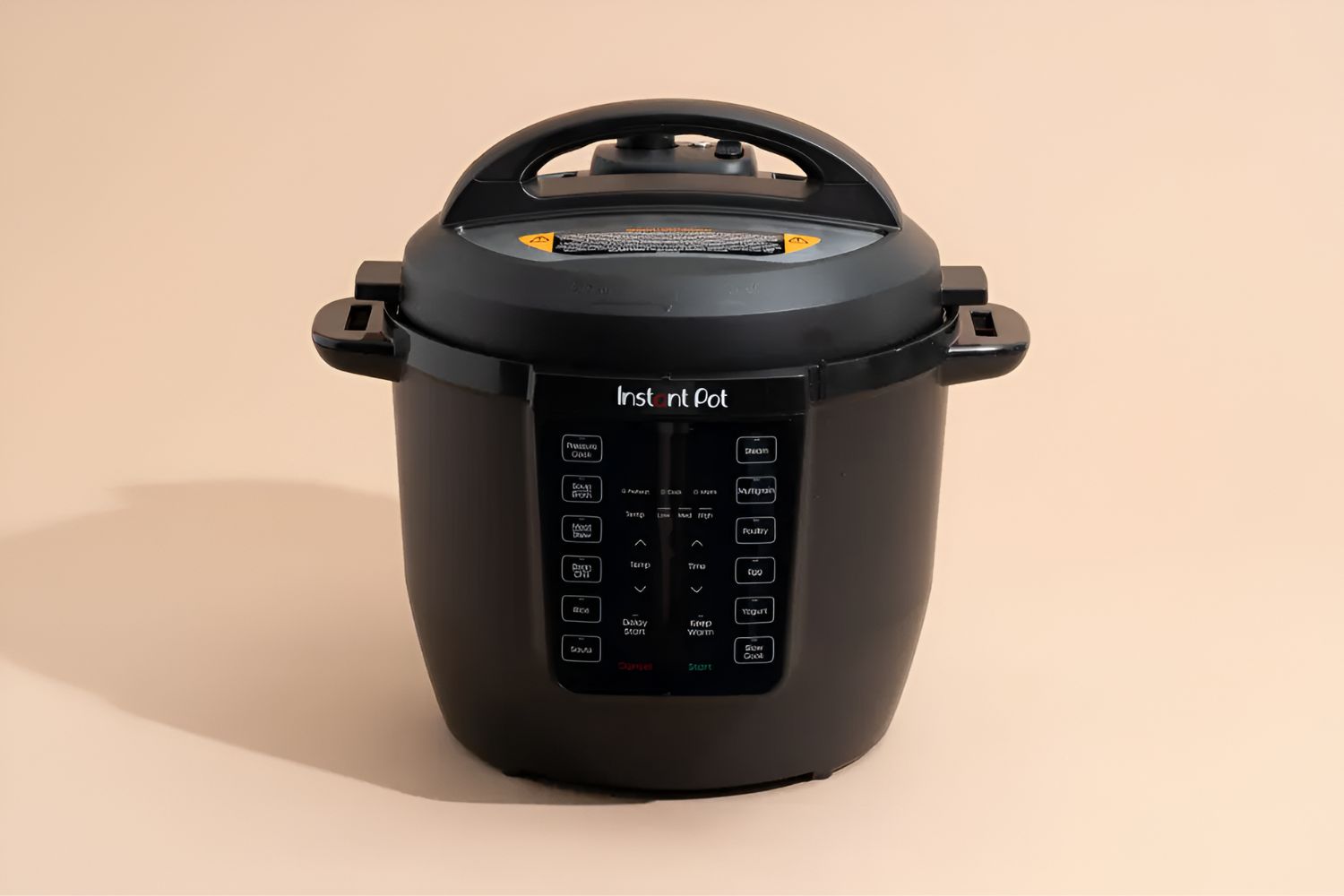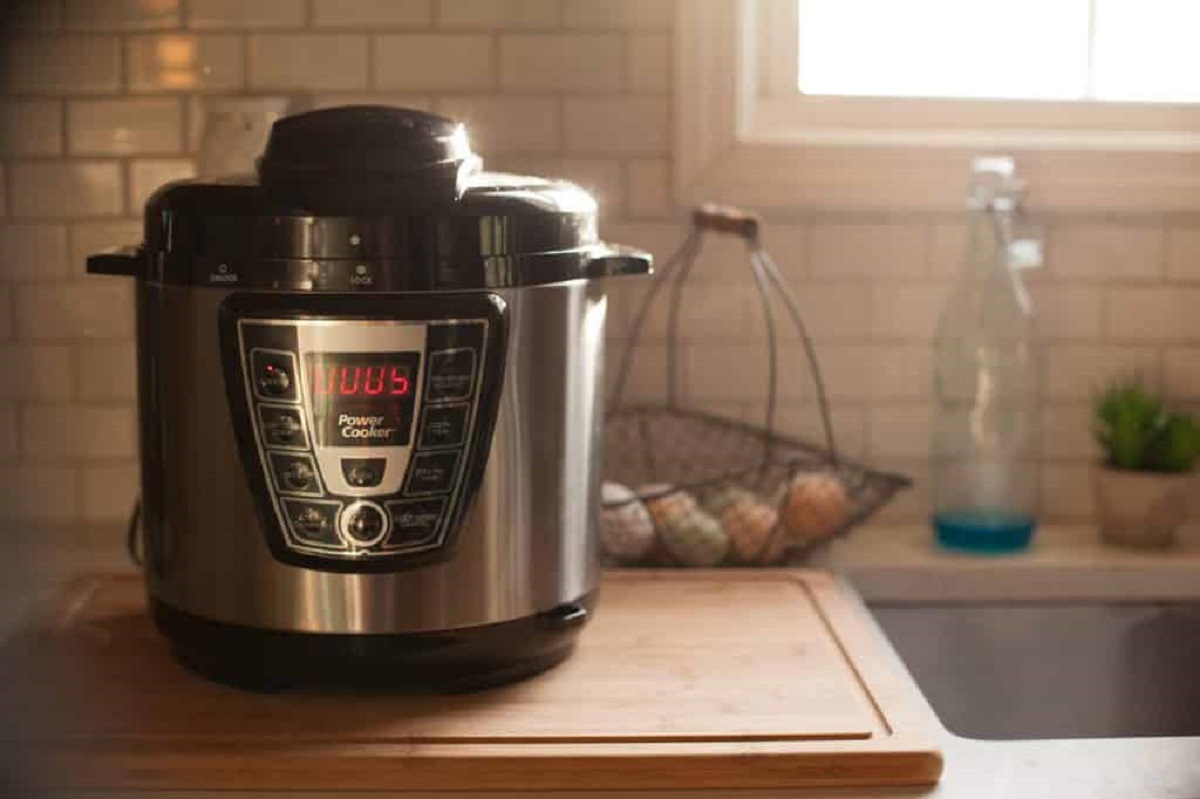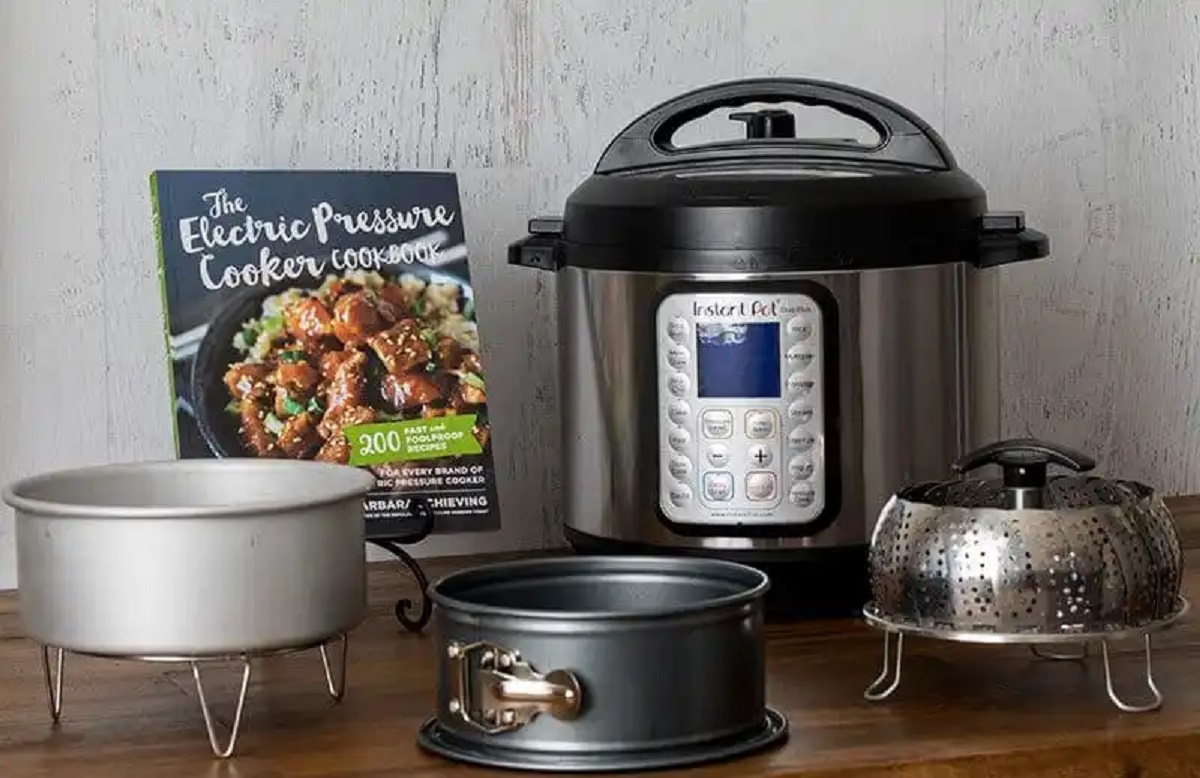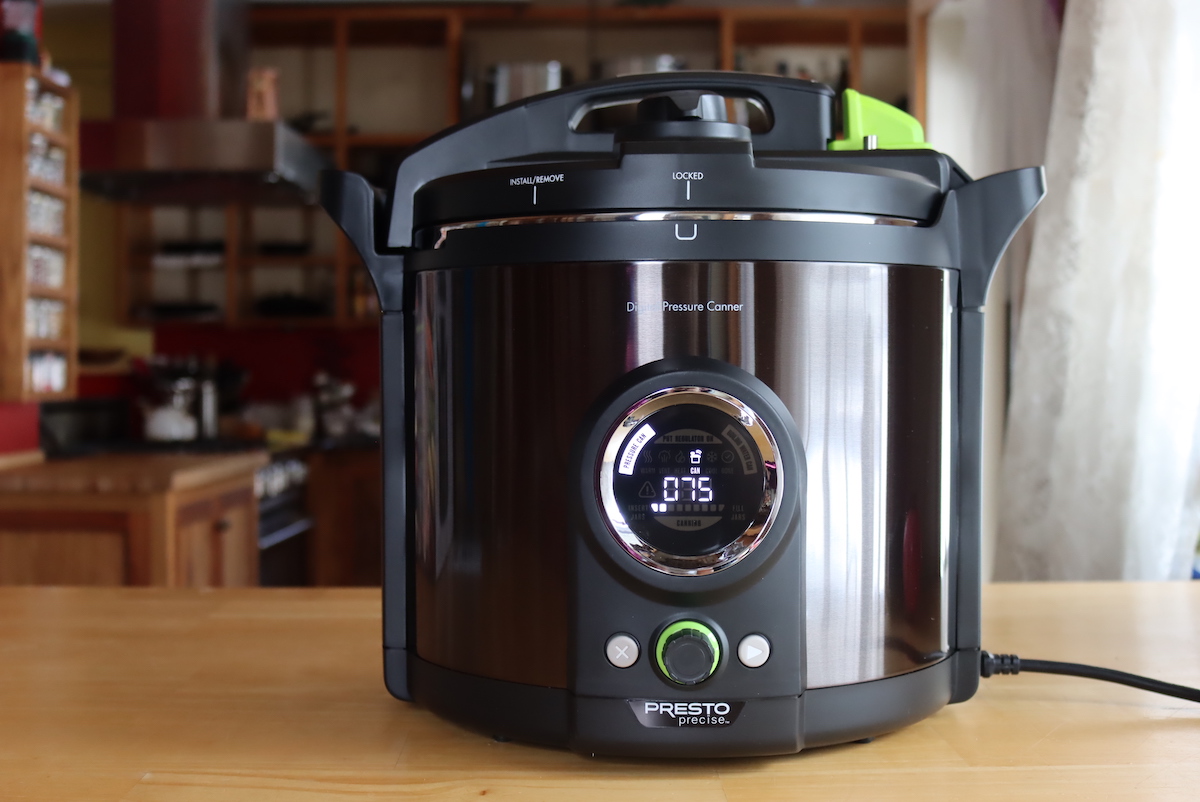Introduction
Welcome to the wonderful world of cooking meatloaf in an electric pressure cooker! If you’re looking for a delicious and convenient way to prepare this classic dish, you’ve come to the right place. With the help of modern kitchen technology, you can now enjoy tender and flavorful meatloaf in a fraction of the time it takes to bake it in the oven.
An electric pressure cooker is a versatile and efficient appliance that uses steam and pressure to cook food quickly. When it comes to cooking meatloaf, the pressure cooker locks in all the flavors and juices, resulting in a moist and tender dish. Plus, the high-pressure environment helps to break down the proteins in the meat, making it easier to slice and serve.
But before we dive into the cooking process, let’s go over a few key points. First, choosing the right meat is essential for a successful meatloaf. Ground beef is the go-to choice, but you can also use a combination of meats like beef, pork, and veal for added flavor. Second, preparing the ingredients properly and mixing them well will ensure a consistent and delicious meatloaf. Lastly, adding flavorings and seasonings of your choice will give your meatloaf a unique twist.
So, whether you’re a cooking enthusiast or someone who wants to make a wholesome dinner in a flash, cooking meatloaf in an electric pressure cooker is a fantastic option. In this guide, we will walk you through each step of the process, from choosing the meat to serving it up on a plate. So grab your apron, prep your ingredients, and let’s get cooking!
Choosing the Right Meat for Meatloaf
When it comes to making a delicious meatloaf, selecting the right type of meat is crucial. While ground beef is the most common choice, there are other options you can explore to enhance the flavor and texture of your meatloaf.
If you prefer a leaner meatloaf, lean ground beef (90% lean) is a great choice. This will result in a healthier dish with less fat content. However, keep in mind that leaner meat may tend to be drier compared to meat with a higher fat content.
For a richer and juicier meatloaf, consider using ground beef with a slightly higher fat content, around 80% lean. The additional fat adds flavor and helps keep the meatloaf moist during the cooking process.
If you’re feeling adventurous, you can experiment with a combination of meats. Combining ground beef with ground pork or ground veal can add complexity to the flavor profile of your meatloaf. It’s all about finding the perfect balance to suit your taste preferences.
When selecting the meat, opt for freshly ground meat if possible. This will ensure a higher quality and more flavorful meatloaf. If you cannot find freshly ground meat, choose packaged ground meat that is as fresh as possible and has not expired.
Lastly, consider the texture you want to achieve in your meatloaf. Some people prefer a denser texture, while others enjoy a more tender and light texture. The type of meat you choose and the way you handle and mix the ingredients will impact the final texture of your meatloaf.
Take some time to think about the flavor and texture profile you want to achieve and choose your meat accordingly. Remember, the quality and type of meat you choose will greatly influence the overall taste and enjoyment of your meatloaf.
Preparing the Ingredients
Now that you have chosen the perfect meat for your meatloaf, it’s time to prepare all the other ingredients that will contribute to its deliciousness. Proper preparation of the ingredients ensures that each bite is flavorful and well-balanced.
Start by gathering all the necessary ingredients listed in your favorite meatloaf recipe. Apart from the main meat, you will typically need breadcrumbs, eggs, onions, garlic, and various seasonings. Make sure to measure and prepare each ingredient in advance to streamline the cooking process.
Next, prepare the onions and garlic. Finely chop the onions and mince the garlic cloves. Sauté them in a pan with a bit of oil until they become translucent and fragrant. This step helps to enhance the flavors of the onions and garlic, ensuring that their taste is evenly distributed throughout the meatloaf.
In a large bowl, combine the ground meat, breadcrumbs, eggs, sautéed onions, minced garlic, and any other ingredients specified in your recipe. Season generously with salt, pepper, and herbs or spices of your choice. Now, it’s time to mix everything together.
Using your clean hands or a sturdy spoon, thoroughly mix all the ingredients until they are well incorporated. Make sure the breadcrumbs are evenly distributed, and the mixture has a uniform texture. Avoid overmixing the meat mixture as this can result in a dense and tough meatloaf.
Once the ingredients are evenly mixed, it’s time to shape the meatloaf. You can either form a traditional loaf shape or opt for individual-sized meatloaf portions. Place the shaped meatloaf on a plate or tray temporarily while you prepare the pressure cooker.
By taking the time to properly prepare and mix the ingredients, you are setting the foundation for a delicious and well-balanced meatloaf. Each ingredient will contribute its unique flavor, and the combination of textures will make your meatloaf a memorable dish.
Mixing and Shaping the Meatloaf
Now that you have prepared all the ingredients for your meatloaf, it’s time to mix them together and shape the perfect loaf. This step is crucial in ensuring that the flavors are well distributed and the meatloaf holds its shape during cooking.
To begin, transfer the prepared meat mixture to a clean, flat surface or a mixing bowl. Using your hands, gently knead and fold the mixture until all the ingredients are fully incorporated. Be careful not to overmix, as this can result in a dense and tough meatloaf. Mix just enough to combine all the ingredients evenly.
If the mixture feels too wet or sticky, add a small amount of breadcrumbs to help absorb the excess moisture. Conversely, if the mixture feels too dry, you can add a bit of moisture by incorporating some broth or water, a tablespoon at a time, until the desired texture is achieved.
Once the mixture is well-mixed, it’s time to shape the meatloaf. For a traditional loaf shape, form the mixture into an oval or rectangular shape on a greased or lined baking sheet. Use your hands to smooth out the surface and shape the sides, ensuring an even and uniform shape throughout.
If you prefer individual-sized portions, you can divide the mixture into smaller portions and shape them into individual loaves. You can use a loaf pan or individual ramekins to hold the shaped meatloaves.
While shaping the meatloaf, be mindful of the size and thickness. Thicker loaves will take longer to cook, so adjust the shape accordingly based on your desired cooking time. Additionally, avoid pressing the meat mixture too tightly as this can result in a dense texture.
Once the meatloaf or meatloaves are shaped, you’re ready to move on to the next step. Whether you’re cooking your meatloaf in an electric pressure cooker or transferring it to a baking dish for the oven, the shape and structure of the meatloaf is essential for even cooking and an appealing presentation.
Now that you have skillfully mixed and shaped your meatloaf, it’s time to move on to adding flavors and seasonings to take it to the next level of deliciousness.
Adding Flavors and Seasonings
One of the joys of making meatloaf is the ability to customize the flavors and seasonings to suit your taste preferences. While the basic ingredients provide a solid foundation, adding extra flavors can take your meatloaf to the next level of deliciousness. Here are some ideas to enhance the taste of your meatloaf:
1. Herbs and spices: Experiment with a variety of herbs and spices to add depth and complexity to your meatloaf. Popular choices include parsley, thyme, rosemary, oregano, paprika, and cayenne pepper. Feel free to adjust the quantities to suit your taste.
2. Sauces and condiments: Add a splash of Worcestershire sauce, soy sauce, or barbecue sauce to infuse your meatloaf with savory and tangy flavors. Ketchup or tomato paste can also add a touch of sweetness and richness.
3. Cheese: For an extra indulgence, incorporate shredded cheese into the meatloaf mixture. Cheddar, mozzarella, or Parmesan can add creaminess and a burst of flavor when melted throughout the loaf.
4. Vegetables: Sneak in some extra nutrients and flavors by adding finely diced vegetables to your meatloaf. Onions, bell peppers, carrots, and mushrooms are popular choices that provide texture and subtle sweetness.
5. Breadcrumbs or oats: While breadcrumbs are typically used as a binding agent, you can experiment with different types of breadcrumbs or even substitute them with rolled oats for added texture and a healthy twist.
Remember to season your meatloaf mixture with salt and pepper to enhance the overall taste. Don’t be afraid to taste the mixture before shaping the loaf to ensure that the flavors are well-balanced.
Once you have added your desired flavors and seasonings, mix them well into the meat mixture until evenly distributed. This will ensure that each bite of the meatloaf is infused with the delicious flavors you have chosen.
Adding your own special touches and experimenting with different flavor combinations is what makes meatloaf a versatile and enjoyable dish. So, get creative and make a meatloaf that truly reflects your taste preferences.
Preparing the Pressure Cooker
Now that you have prepared the meatloaf mixture, it’s time to get your electric pressure cooker ready for cooking. Here are the steps to ensure a successful cooking process:
1. Check the manual: Before using your electric pressure cooker, consult the user manual for specific instructions and safety precautions. Familiarize yourself with the different parts of the pressure cooker and understand how to operate it properly.
2. Add liquid: Most electric pressure cookers require a minimum amount of liquid to create the necessary steam for cooking. Check the manufacturer’s instructions for the recommended amount of liquid, but a general rule of thumb is around 1 to 2 cups of liquid. You can use water, broth, or even a combination of both for added flavor.
3. Grease the cooking insert: To prevent the meatloaf from sticking, lightly grease the cooking insert of the pressure cooker with cooking spray or a small amount of oil. This will make it easier to remove the meatloaf once it’s cooked.
4. Place a trivet: Depending on the size and model of your electric pressure cooker, you may need to place a trivet or a metal rack at the bottom of the cooking insert. This elevates the meatloaf slightly, allowing the steam to circulate evenly around the meat and promote even cooking.
5. Preheat the pressure cooker: Some electric pressure cookers require a preheating step before adding the food. Check your appliance’s instructions to see if preheating is necessary. If it is, select the appropriate preheating function or set the cooking time to zero and let the pressure cooker heat up for a few minutes before moving on to the next step.
By following these steps, you are ensuring that the pressure cooker is set up and ready to provide the optimal cooking environment for your meatloaf. The liquid in the pressure cooker will generate steam that will cook the meatloaf under pressure, resulting in a moist and flavorful dish.
With the pressure cooker prepared, it’s time to transfer the meatloaf into the cooker and start the cooking process. We will cover this in the next section, where you will learn how to cook the meatloaf to perfection.
Cooking the Meatloaf
Now that your pressure cooker is prepared, it’s time to cook the meatloaf to perfection. Follow these steps to ensure a tender and flavorful result:
1. Transfer the meatloaf: Gently place the shaped meatloaf onto the trivet or rack inside the pressure cooker. Handle it with care to maintain its shape and prevent it from falling apart.
2. Seal the pressure cooker: Securely close the lid of the pressure cooker, ensuring that it is properly aligned and the sealing ring is in place. This will create a tight seal, allowing the pressure to build up during cooking.
3. Select the cooking mode: Follow your pressure cooker’s instructions to select the appropriate cooking mode. Most electric pressure cookers have a “Manual” or “Pressure Cook” function, which allows you to set the cooking time and pressure manually.
4. Set the cooking time: Depending on the size and thickness of your meatloaf, set the cooking time as specified in your recipe. Typically, meatloaf cooked in a pressure cooker takes around 15 to 20 minutes on high pressure. Adjust the cooking time accordingly for larger or smaller portions.
5. Start the cooking process: Once you have set the cooking time and pressure, press the start button or whichever button is designated to begin the cooking process. The pressure cooker will now start to build up pressure and cook the meatloaf.
6. Allow for the natural release or quick release: After the cooking time is complete, you have the option of performing either a natural release or a quick release. A natural release involves letting the pressure cooker naturally release the pressure over time, which can take around 10 to 15 minutes. Alternatively, you can opt for a quick release by carefully turning the pressure release valve to release the steam.
Once the pressure inside the cooker has completely released and the pressure indicator has dropped, it is safe to open the lid. Always follow the manufacturer’s instructions regarding releasing pressure to ensure your safety.
With the lid removed, you’ll be greeted by the delicious aroma of your perfectly cooked meatloaf. Use a meat thermometer to check the internal temperature, which should register at least 160°F (71°C) to ensure that the meatloaf is fully cooked.
Now that your meatloaf is cooked, you can move on to the next step to add the finishing touches and serve up a mouthwatering dish.
Natural Release vs. Quick Release
When cooking meatloaf in an electric pressure cooker, you have the option of using either a natural release or a quick release method to release the pressure after the cooking time is complete. Each method has its advantages and considerations, so let’s explore both:
Natural Release: With a natural release, you allow the pressure inside the cooker to naturally decrease over time without interfering. This is typically done by leaving the pressure cooker undisturbed for approximately 10 to 15 minutes after the cooking time is complete.
The natural release method is generally recommended for meat dishes, including meatloaf. It allows the meat to rest and continue cooking in the residual heat of the pressure cooker. This results in a more tender and evenly cooked meatloaf. Additionally, natural release helps to prevent the meat from becoming dry or tough by allowing the juices to redistribute throughout the meat.
However, keep in mind that the natural release method can take longer and may not be suitable if you’re short on time. If you’re pressed for time or need to quickly release the pressure from the cooker, you can opt for a quick release instead.
Quick Release: Quick release involves manually releasing the pressure from the pressure cooker immediately after the cooking time is complete. This is done by carefully and slowly turning the pressure release valve to quickly release the steam and pressure inside the cooker.
The quick release method is convenient when you need to stop the cooking process right away or if you’re running short on time. It allows you to move on to the next steps of your recipe more quickly.
However, be cautious when performing a quick release, as the steam released from the pressure cooker can be hot and cause burns if not handled properly. Follow the manufacturer’s instructions for safely releasing the pressure to prevent any accidents.
Whether you choose a natural release or a quick release, both methods have their merits depending on the recipe and your time constraints. It’s essential to consider the recipe instructions and your own preferences when deciding which method to use.
Now that you understand the differences between natural release and quick release, it’s time to move on to the next step and test your meatloaf for doneness.
Testing for Doneness
Testing for doneness is a crucial step when cooking meatloaf in an electric pressure cooker. Unlike traditional baking methods, it can be challenging to visually determine if the meatloaf is fully cooked. Here are a few methods you can use to ensure that your meatloaf is cooked to perfection:
Use a Meat Thermometer: The most accurate way to test for doneness is by using a meat thermometer. Insert the thermometer into the thickest part of the meatloaf, making sure it doesn’t touch the sides or bottom of the pressure cooker. The internal temperature should register at least 160°F (71°C) to ensure that the meatloaf is fully cooked and safe to eat.
Check for Firmness: Gently press the top of the meatloaf with a spoon or fork. If it feels firm and holds its shape, it is likely cooked through. If it feels soft or gives in easily, it may need more cooking time.
Inspect the Juices: Carefully release the pressure and open the pressure cooker. Check the color and consistency of the juices released by the meatloaf. If the juices are clear and not pink, it is a good indication that the meatloaf is fully cooked. If the juices are still pink or cloudy, the meatloaf may need additional cooking time.
Remember, undercooked meatloaf can pose health risks, so it’s important to ensure it is fully cooked before serving. If necessary, you can put the meatloaf back in the pressure cooker for a few more minutes or use the sauté function to cook it further.
Once you have confirmed that the meatloaf is cooked through, it’s time to add the finishing touches and prepare it for serving. So, let’s move on to the next section to learn about the final steps for this delectable dish!
Finishing Touches and Serving Suggestions
Now that your meatloaf is cooked to perfection, it’s time to add some finishing touches and get ready to enjoy a delicious meal. Here are some ideas for adding extra flavor and presenting your meatloaf in an appealing way:
Glaze or sauce: For an extra burst of flavor, brush the top of the meatloaf with your favorite glaze or sauce. Whether it’s a tangy barbecue glaze, a savory tomato-based sauce, or a sweet and sticky glaze, it will add a delightful layer of flavor to the meatloaf.
Oven finish: If you prefer a crispy exterior, you can transfer the cooked meatloaf to a baking dish and broil it in the oven for a few minutes. This will create a slightly caramelized crust on top, adding both texture and flavor to the meatloaf.
Serve with a side dish: Meatloaf pairs well with a variety of side dishes. Consider serving it with classic mashed potatoes, roasted vegetables, creamy coleslaw, or a fresh green salad. These sides will complement the hearty flavors of the meatloaf and create a well-rounded meal.
Garnish: Sprinkle some fresh herbs, such as parsley or thyme, over the top of the meatloaf before serving. Not only will it add a pop of color, but it will also enhance the overall look and presentation of the dish. You can also top it with some grated cheese or crispy fried onions for added texture and flavor.
Slice and serve: Once you’ve added the finishing touches, let the meatloaf rest for a few minutes to allow the flavors to meld together. Then, carefully slice the meatloaf into thick, juicy slices and plate it up. Garnish with any remaining sauce or glaze and arrange the side dishes alongside.
Now, you’re ready to sit down and savor the scrumptious meatloaf you’ve prepared. Enjoy the combination of flavors and textures, and don’t forget to share this comforting dish with family and friends.
Experiment with different seasonings, glazes, and sides to create a personalized meatloaf experience. The possibilities are endless, and you can make this classic dish your own with each variation you try.
Cooking meatloaf in an electric pressure cooker makes it a convenient and efficient option for a hearty and satisfying meal. So, go ahead and enjoy the fruits of your labor!
Conclusion
Cooking meatloaf in an electric pressure cooker allows you to enjoy a tender, moist, and flavorful dish in a fraction of the time it would take in the oven. With the right choice of meat, proper ingredient preparation, and the addition of your favorite flavors and seasonings, you can create a mouthwatering meatloaf that will impress family and friends.
From selecting the perfect meat and mixing the ingredients to preparing the pressure cooker and cooking the meatloaf, each step is crucial in achieving the best results. The choice between natural release and quick release, as well as the testing for doneness, ensures that your meatloaf is cooked to perfection.
Remember to add your personal touch with glazes, sauces, and garnishes, and pair your meatloaf with delicious side dishes to create a balanced and satisfying meal. Whether you opt for a classic recipe or get creative with different flavor combinations, cooking meatloaf in an electric pressure cooker opens up a world of culinary possibilities.
So, put on your apron, gather your ingredients, and let your electric pressure cooker do the work. With these steps and tips in mind, you’ll be well on your way to cooking a delectable meatloaf that will have everyone coming back for seconds.
Embrace the convenience and efficiency of the electric pressure cooker, and enjoy the delightful flavors and aromas of homemade meatloaf. Happy cooking!







